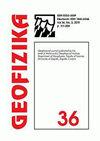Properties of the Zagreb 22 March 2020 earthquake sequence
IF 1.1
4区 地球科学
Q4 GEOCHEMISTRY & GEOPHYSICS
引用次数: 4
Abstract
Although strong and damaging earthquakes have hit Zagreb in the past, the 22 March 2020 earthquake (Mw 5.4) is the first one that was recorded by a modern digital local seismic network, and which could be analysed not only by macroseismic methods, but also by microseismic ones. Herewith we used the 3003 carefully analysed and located events from the first year of the aftershock sequence to learn more about the aftershock rate decay, their magnitude distribution, focal mechanisms and hypocentral locations. The aftershock activity rate was found to closely follow the modified Omori law, and fault-plane solutions for 10 events indicated prevailing pure-reverse faulting. Our analyses suggest that the reverse North Medvednica boundary fault (NMBF) was the causative fault, as it fits with the focal mechanisms and with the geometry of aftershock locations. The epicentral area was of a triangular shape with the mainshock in one vertex, and the opposite side of the triangle lying parallel to the surface trace of the NMBF. The hypocentres of aftershocks were predominantly located in the hanging wall of the fault. No surface break was observed, so the rupture is assumed to be buried. These facts were interpreted as a combination of the effect of conservation of mass (seismic flow) requiring some fault-parallel stress redistribution and transfer of material, and the fault loading and activation in the compressive environment controlled by the stress partition at the brittle-ductile transition zone within the crust. The later process involves compression within the hanging wall during the interseismic stage when the fault segment in the brittle crust is locked, followed by sudden dilatation during the rupture phase.2020年3月22日萨格勒布地震序列的特性
尽管萨格勒布过去曾发生过强烈的破坏性地震,但2020年3月22日的地震(5.4级)是现代数字地方地震网络记录的第一次地震,不仅可以通过宏观地震方法进行分析,还可以通过微震方法进行分析。在此,我们使用3003次仔细分析和定位的余震序列第一年的事件来了解更多关于余震率衰减、震级分布、震源机制和震源位置的信息。余震活动率被发现密切遵循修正的大森定律,10个事件的断层平面解表明盛行的纯逆断层作用。我们的分析表明,北Medvednica逆边界断层(NMBF)是成因断层,因为它符合震源机制和余震位置的几何形状。震中区呈三角形,主震位于一个顶点,三角形的另一侧与NMBF的表面轨迹平行。余震的震源主要位于断层上盘。没有观察到表面破裂,因此假设破裂被掩埋。这些事实被解释为需要一些断层平行应力再分配和物质转移的质量守恒(地震流)效应,以及地壳内脆韧性过渡带应力分区控制的压缩环境中的断层加载和激活的组合。后期过程包括在地震间阶段,当脆性地壳中的断层段被锁定时,上盘内的压缩,然后在破裂阶段突然膨胀。
本文章由计算机程序翻译,如有差异,请以英文原文为准。
求助全文
约1分钟内获得全文
求助全文
来源期刊

Geofizika
地学-地球化学与地球物理
CiteScore
1.60
自引率
0.00%
发文量
17
审稿时长
>12 weeks
期刊介绍:
The Geofizika journal succeeds the Papers series (Radovi), which has been published since 1923 at the Geophysical Institute in Zagreb (current the Department of Geophysics, Faculty of Science, University of Zagreb).
Geofizika publishes contributions dealing with physics of the atmosphere, the sea and the Earth''s interior.
 求助内容:
求助内容: 应助结果提醒方式:
应助结果提醒方式:


